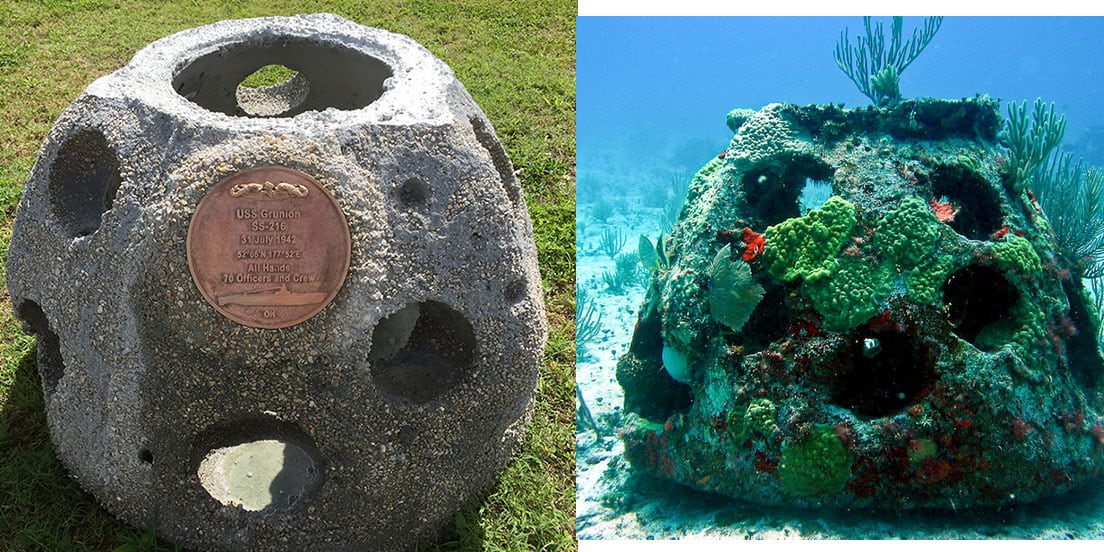An artificial reef will be created over the next few months honoring the 65 submarines and more than 4,000 submariners lost at sea since the Navy’s undersea force was created in 1900.
Scattered across the world’s oceans, these boats are said to be on “Eternal Patrol” because they never came back.
And that’s why a proposed living tribute to them is called the “On Eternal Patrol Memorial Reef.”
The culmination of a five-year effort by United States Submarine Veterans, Inc. and the Florida-based nonprofit Eternal Reefs, planners hope to place it on the ocean floor in the Gulf of Mexico, about 60 feet under the waves and nine miles off the coast of Sarasota.
Supporters want it to not only become a site where loved ones can entomb the ashes of submariners forever but also a diving attraction so visitors can pay their respects in person.
“This is the first and only memorial honoring the sacrifice of these submariners in the environment in which they served — the ocean,” said George Frankel, the chief executive officer of Sarasota-based Eternal Reefs.
Since 1998, Eternal Reefs has created nearly 2,000 underwater memorials in 25 locations along the Atlantic and Gulf Coasts, according to the organization.

The idea is a marriage between environmentalists and submarine veterans.
To submariners, it keeps the memories of fallen sailors alive; by creating coral reefs, environmentalists help protect shorelines from storms and erosion, preserve wetlands and provide shelter to marine organisms at risk from global climate change and pollution.
The project is slated to kick off on May 22, the 51st anniversary of the loss of the Norfolk-based fast-attack submarine Scorpion.
It went down in the Atlantic in 1968, taking all 99 of its crew.
Frankel told Navy Times the reef will be created by laying 67 concrete domes close to each other on the seabed.
Vented, they look like giant gray Whiffle Balls. Because their weight is concentrated at the bottom of the dome and holes let water flow through them, they’re designed to withstand the force of heavy seas.
“The concrete is specially formulated to be neutral chemically, much like that natural strata where natural reefs form,” Frankel said. “This, along with a textured surface, encourages marine life to grow quickly, really, and you can see it growing usually after just a few days.”
Affixed to the balls will be brass plaques that identify the lost submarine, its last known location and the number of officers and crew on board when it began its eternal patrol.
Frankel said that 65 of the domes will be dedicated to specific boats. Another will pay homage to United States Submarine Veterans Inc. — or USSVI ― and a second will honor the entire community of submariners, including those killed in non-sinking incidents.
Most of the balls will recall World War II losses, when 52 boats never came home. Before the conflict ended, 3,506 officers and submariners were killed.
On May 22, four domes are scheduled to be lowered to the ocean floor.
Each honors the boats lost since World War II — Cochino, which sank off the coast of Norway in 1949; Stickleback, lost after a 1958 collision with the destroyer escort Silverstein off Hawaii; the nuclear-powered Thresher, which never came up from a deep-diving test off Cape Cod in 1963; and Scorpion.
The other balls commemorating lost boats will be added during the summer.
“Really our whole purpose is to honor those of us who never came home,” said William Andrea, a former National Junior Vice Commander of USSVI. “The idea of recognizing those on eternal patrol with something that will live on forever — and being under the ocean, too — is something that resonates with our members.”
Submarine veterans have contacted the organizations asking to rest eternally at the reef, too. The idea is to bring a string of pearls to the scattering of balls.
“The site has already been approved for this and along with the balls, we have what we call ‘pearls,’” Frankel said. “We mix the same proprietary concrete with cremains that can be shaped and decorated by family members.”
On the seabed, the pearls also will attract marine life and become mini-reefs, Frankel said.
Mark D. Faram is a former reporter for Navy Times. He was a senior writer covering personnel, cultural and historical issues. A nine-year active duty Navy veteran, Faram served from 1978 to 1987 as a Navy Diver and photographer.





